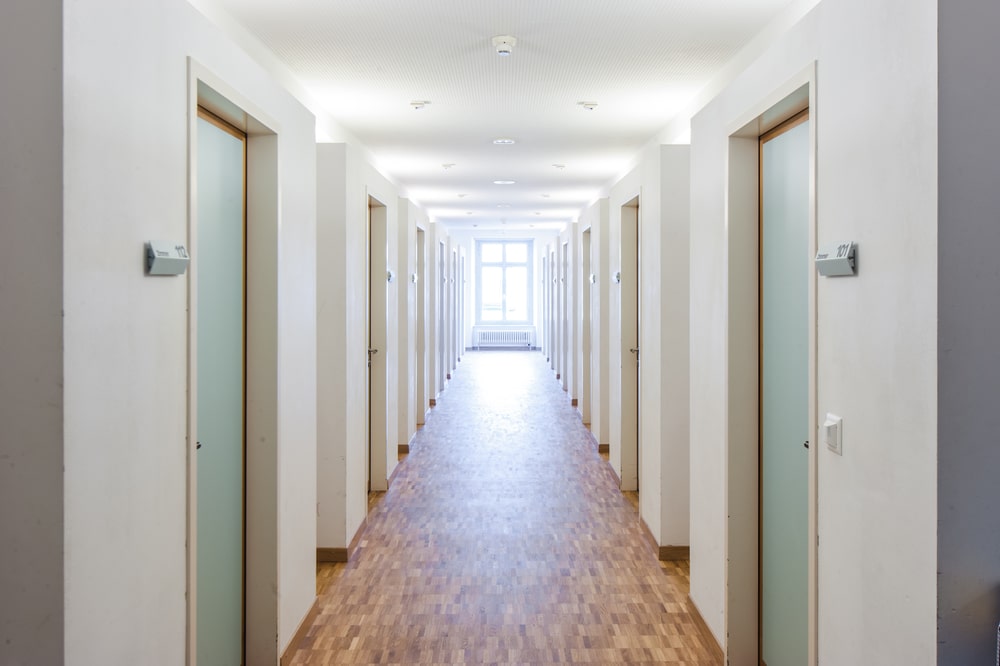Decorating your dorm room at Duke University is an exciting yet daunting task. Finding the perfect balance between comfort, utility, and style within a small space is no easy feat. However, with careful planning, a splash of creativity, and adherence to dorm room guidelines, you can completely transform your Duke dorm room into an inviting oasis that reflects your personality.
Understanding Duke University’s Dorm Room Policies
It’s crucial to first familiarize yourself with Duke University’s dorm room policies before embarking on your decorating journey. This will help you discern what you can and can’t bring into your room, ensuring you do not invest in prohibited items.
Living in a dorm room at Duke University offers a unique experience, where students have the opportunity to personalize their living space while adhering to certain guidelines. Let’s dive deeper into the policies to ensure you have a clear understanding.
Prohibited Items in Duke Dorm Rooms
The first step to decorating your Duke dorm room is to understand what you should avoid. Duke University prohibits items such as candles, incense, space heaters, and any other devices that can cause fire. This policy ensures the safety and well-being of all residents.
Additionally, halogen lamps and lava lamps are not allowed due to their potential fire hazards. The university prioritizes the prevention of accidents and the preservation of the dormitory infrastructure.
It’s important to note that Duke University also discourages the use of items that can cause damage to the walls and ceiling. Nails, screws, and duct tape are strictly prohibited as they can leave permanent marks and require costly repairs. Hence, adhesive strips that don’t peel off the paintwork are preferable for hanging decorations and pictures.
By adhering to these guidelines, you not only ensure your safety but also contribute to maintaining the integrity of the dormitory facilities for future residents.
Permitted Decorations in Duke Dorm Rooms
While there are restrictions, there is also a wide array of decorative items you’re allowed to bring. Duke University encourages students to personalize their living spaces to create a comfortable and welcoming environment.
You can bring carpets to add warmth and coziness to your room. Curtains can be used to enhance privacy and create a personalized touch. Posters are a popular choice among students, allowing them to showcase their interests and passions.
If you’re looking for a way to add a touch of creativity to your walls, removable wall decals are a great option. These decals come in various designs and can be easily applied and removed without causing any damage.
Bringing plants into your dorm room can also create a refreshing and vibrant atmosphere. Not only do they add aesthetic appeal, but they also have the added benefit of improving air quality.
Furthermore, Duke University allows students to bring certain electronics into their dorm rooms. A TV can be a great source of entertainment during downtime, while a refrigerator and microwave provide convenience for storing and preparing snacks. However, it’s important to note that these appliances are subject to size restrictions, so it’s always advisable to check with your Housing Coordinator before making any purchases.
As you embark on your journey of decorating your Duke dorm room, remember to strike a balance between personalization and adhering to the university’s policies. By doing so, you can create a space that reflects your individuality while ensuring a safe and comfortable living environment for yourself and your fellow residents.
Planning Your Dorm Room Decor at Duke University
Planning is key in dorm room decoration. A well-planned room will not only be aesthetically pleasing but will also yield optimal functionality.
When it comes to planning your dorm room decor, there are several factors to consider. From assessing your space to choosing a color scheme and balancing function and aesthetics, each step plays a crucial role in creating a comfortable and stylish living environment.
Assessing Your Space
Before committing to any major purchases, take the time to assess your room. Consider the size and layout of your room along with any furniture that’s included. This assessment will enable you to determine what can fit in your room and where.
For example, you could consider a loft bed to maximize space, a bedside table for proximity storage, or an under-the-bed storage box for clothes and textbooks. Having a clear mental image of your room will aid in effective shopping.
Additionally, think about the overall flow of your room. How will you arrange your furniture to create a functional and visually appealing space? Will you have designated areas for studying, relaxing, and sleeping? These are important questions to consider as you plan your dorm room decor.
Choosing a Color Scheme
The color scheme of your dorm room will largely define its ambiance. Decide whether you want a calming and relaxing neutral tone, a vibrant and lively color, or a sleek and modern monochrome palette. Whatever you choose, make sure it reflects your personal style and mood.
Once you’ve decided on a color scheme, you can then coordinate your bedding, curtains, rugs, and accessories to create a stylish and harmonious look. Consider incorporating different textures and patterns to add depth and visual interest to your room.
Remember, your dorm room is your personal sanctuary, so don’t be afraid to let your personality shine through your color choices. Whether you prefer bold and vibrant hues or soft and soothing tones, the color scheme you choose will set the tone for your entire space.
Balancing Function and Aesthetics
While it’s important to have a visually pleasing dorm room, it’s equally vital to ensure your room is functional. Aim for a balance between style and utility. Each element in your room should serve a purpose, be it practical or aesthetic.
Consider multi-purpose furniture like a desk that can serve as both a study area and a vanity. Opt for storage units that are visually appealing and can double as décor pieces. This way, you can maximize functionality without compromising style.
Furthermore, think about the specific needs of your daily routine. Do you require ample storage for books and school supplies? Would a comfortable seating area be beneficial for socializing with friends? By considering these factors, you can create a dorm room that not only looks great but also enhances your daily life.
Lastly, don’t forget to incorporate personal touches into your decor. Display photographs, artwork, or sentimental items that bring you joy and make your dorm room feel like home. These small details can make a big difference in creating a space that is uniquely yours.
In conclusion, planning your dorm room decor is an exciting process that requires careful consideration. By assessing your space, choosing a color scheme, and balancing function and aesthetics, you can create a dorm room that is both visually appealing and functional. So, take your time, explore different options, and have fun transforming your dorm room into a cozy and stylish haven.
Essential Dorm Room Decorations at Duke University
Once you’ve assessed your space, chosen a color scheme, and considered functionality, it’s time to get to the fun part – shopping for your dorm room essentials.
But before you dive into the world of dorm room decor, let’s take a moment to explore some additional options that can make your space truly unique and personalized.
First and foremost, let’s talk about the importance of a comfortable bed. Dorm beds are notorious for being less than ideal in terms of comfort, so investing in quality bedding materials can greatly enhance your sleep and overall well-being. Consider opting for a memory foam mattress topper or a cozy down comforter to make your bed feel like a cloud.
Bedding and Pillows
In addition to comfort, bedding is also one of the largest decor surfaces in your room, so it should align with your color scheme and overall style. Don’t be afraid to mix and match patterns and textures to create a visually appealing and inviting bed.
And let’s not forget about pillows! Adding a few decorative pillows can enhance your bed’s appearance while providing a cozy lounging spot for studying or hanging out with friends. Opt for pillows with different shapes, sizes, and textures to add depth and visual interest to your bed.
Wall Decorations
Now, let’s turn our attention to the walls. Walls offer a wide space for personalized decor, so don’t be afraid to get creative. In addition to pictures, posters, and removable decals, consider incorporating other unique elements.
For a truly unique and personal touch, why not create a photo wall showcasing your favorite memories? Print out your favorite photos and arrange them in a visually appealing way. You can even add fairy lights around the photos to create a cozy and magical atmosphere.
If you’re feeling artsy, consider hanging inspirational quotes or artwork that reflect your creative side. You can even create your own artwork to add a personal touch to your room. Don’t worry if you’re not the best artist – abstract and minimalist designs can be just as impactful.
Lighting Options
Although your dorm room will likely come with basic lighting fixtures, adding additional lighting can truly transform your space. A decorative lamp not only provides extra light but can also serve as a statement decor piece. Look for lamps with unique shapes, colors, or patterns to add a touch of personality to your room.
String lights are also a popular and affordable option when it comes to dorm room decor. They offer soft and warm lighting that can make your room feel cozy and inviting. Hang them around your bed, along the walls, or even across your desk to create a whimsical and enchanting atmosphere.
So, as you embark on your dorm room decoration journey, remember to think outside the box and let your creativity shine. Your dorm room is not just a place to sleep and study – it’s a reflection of your personality and a space where you can truly express yourself.
Organizing Your Dorm Room
A well-organized dorm room saves you time, and space, and reduces stress levels. Here are some helpful tips to keep your room tidy.
When it comes to organizing your dorm room, it’s all about maximizing the limited space you have. Dorm rooms are notoriously small, so optimizing space through clever storage solutions is key. Things like over-the-door hangers, under-bed storage bins, and closet organizers can greatly improve your room’s organization. Not only do these storage solutions help keep your belongings in order, but they also free up valuable floor space.
For your study area, consider a desktop organizer to keep your textbooks and supplies orderly. This will not only make it easier for you to find what you need when studying but also create a visually pleasing and clutter-free workspace. Additionally, investing in a shoe rack can prevent footwear from cluttering your room, keeping the floor clear and making it easier to navigate.
Now that you have your storage solutions in place, it’s time to think about arranging your furniture for optimal space. How you arrange your furniture can significantly affect your room’s space and flow. Place your desk near a natural light source for optimal studying conditions. Natural light not only improves your mood but also helps create a more inviting and productive environment. If possible, try arranging your bed diagonally to give the illusion of more space. This simple trick can make your room feel larger and more open.
Remember, your room should promote movement and accessibility. Avoid overcamping by only putting in essential furniture. It’s important to strike a balance between functionality and aesthetics. Choose furniture pieces that serve multiple purposes, such as a desk with built-in storage or a bed with drawers underneath. This way, you can make the most of your limited space without sacrificing style or comfort.
Maintaining cleanliness is crucial in small spaces like dorm rooms. Develop a cleaning schedule to ensure your room stays tidy. Regularly wash your bedding to keep it fresh and free from allergens. Dust your surfaces to prevent the buildup of dirt and grime. Vacuum your floor to remove any dust or debris that may accumulate. Not only does a clean room look better, but it also promotes a healthier living environment.
In addition to regular cleaning, having designated recycling and trash bins in your dorm room is essential to dispose of waste properly and keep your room clutter-free. Consider getting bins that are compact and fit well in your space. A place to store cleaning supplies, such as a small caddy or basket, would also be beneficial. This way, you can easily access your cleaning supplies whenever you need them.
Lastly, don’t forget to add a personal touch to your dorm room. Decorating your Duke dorm room is a journey of self-expression. Innovate within the provided restrictions and make the space your own. Hang up photos, posters, or artwork that reflects your personality and interests. Incorporate colors and patterns that inspire you. By creating a space that feels like home, you’ll be more motivated to keep it organized and tidy.
Organizing your dorm room may seem like a daunting task, but with these tips, you’ll be well on your way to a tidy and functional space. Remember, a well-organized dorm room not only enhances your living experience but also sets the foundation for a successful academic year. Happy organizing!










































